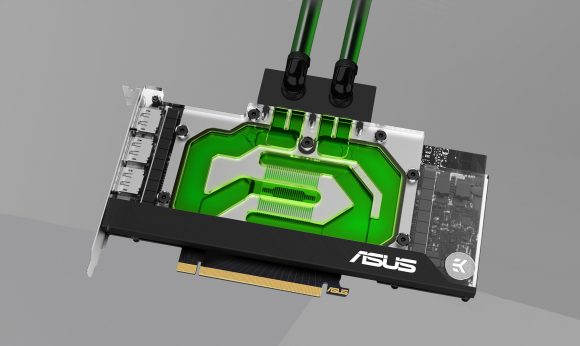
Recently we have built a 720 MHs Ethereum Mining Rig With 6x MSI GeForce RTX 3090 SUPRIM X 24G GPUs and shared our experience with it, and we just got our hands on a water- cooled RTX 3090 GPU form ASUS and had to give it a go for Ethereum mining as well. The ASUS EKWB GeForce RTX 3090 video card is the result of collaboration between ASUS and EK, it comes with EK full-coverage water block and takes up just a single slot.
Specifications wise the ASUS EKWB GeForce RTX 3090 is just like a standard RTX 3090 video card with 350W TDP rating and dual 8-pin PCI-E power connectors that are supplying the required power along with the PCI-E x16 slot (be careful with extender power draw for mining rigs). The EK full cover water block is a high-flow one that should efficiently cool not only the GPU, but also the memory chips and other hot components on the front of the video card and the aluminium backplate at the back should also help with not only keeping things together, but also with cooling. The EK water block is made from copper and is nickel plated for better looks and for improved durability, there is a transparent plexiglass top and an addressable RGB strip with support for ASUS Aura Sync.

Here are some specifications from GPU-Z: the base GPU clock is 1395 MHz, the boost clock is 1695 MHz and the memory clock is 1219 MHz (19.5 Gbps effective) with Micron GDDR6X chips and a 384-bit wide memory bus. That is your typical GA102 GPU specs and what you should expect from an Nvidia RTX 3090 video card that is not factory overclocked. The default TDP of the video card is 350W here (unlike some OC models that come with 420W TDP) even though the GPU is water cooled and you can change it in the range between 28.6% and 104.6%, so not a lot of headroom for overclock – just about 5% extra or 366W max. We are more interested in optimizing TDP for lower power consumption, not aiming for higher with mining though in order to maximize performance and power efficiency.

Running the PhoenixMiner in order to check what Ethereum hashrate can we get with stock settings (default GPU and VRAM clocks and 100% TDP) – no surprise here with the result of 106.8 MH/s with the water-cooled GPU running at 51 degrees Celsius with the power usage reported from the miner is 322W, so it is almost filling up the available 100% Power Limit level. Hashrate for Ethereum in the range of 105-106 MH/s is the normal result for Nvidia RTX 3090 GPUs at default settings. Here we have water cooling on the GPU and memory and that is nice as far as silent operation is required for use in your home computer for example, but that does not mean that things will most definitely be much better compared to good air-cooled RTX 3090 video card. A good air cooler on an Nvidia RTX 3090 can also do around 50 degrees Celsius for the GPU with fans at 100%, though the noise will be more than when using water-cooling.

The more important thing here is the operating temperature of the memory. We were eager to see if the water-cooling improves the situation with the hot video memory on RTX 3090 or not when mining Ethereum (ETH) and the memory is under high load constantly. Unfortunately, even with the water-cooling the temperature of the backplate is still in the 70 degrees Celsius range when mining which is similar to what we’ve already seen on other air-cooled RTX 3090 video cards. Checking the backplate with a thermal imaging camera shows that at stock settings when mining you get around 72.8 C (the hottest spot) and with overclocked memory the hottest spot on the backplate where the memory chips are is 75.8 C, because even though the GPU power consumption is reduced, the memory uses more power due to the higher operating frequency due to the overclock we have applied.

On the ASUS EKWB GeForce RTX 3090 we’ve managed to lower down the Power Limit level to 76% with the video card still capable of providing 106 MH/s hashrate for Ethereum mining with about 266W of power usage reported by the miner (the same hashrate as with 100% TDP). Overclocking the video memory with 1100 MHs over the stock settings in MSI Afterburner and increasing the Power Limit level at 86% allowed us to reach 120.4 MH/s hashrate and 301W of power usage for the video card as reported by the miner software.
Optimized ASUS RTX 3090 EKWB ETH Mining Settings:
– TDP: 86%
– GPU: +0 MHz
– VRAM: +1100 MHz
We got 14 MHS more with 14% less power usage, but we kind of hoped for better results from the water-cooling of the RTX 3090. You can continue pushing the memory clock higher than our sweet spot of +1100 MHz that ensures 120 MH/s hashrate for a few extra megahashes, but we are worried about the memory temperature and the possibility of it starting to throttle because of getting too high. That is why we would recommend to place a cooling fan on top of the GPU backplate to help keep things cooler even if mining Ethereum with stock settings, let alone after you overclock the video memory, so that it will help keep things running optimally and problem free on the long run!
– For more information about the ASUS GeForce RTX3090-24G-EK Water-Cooled GPU…
